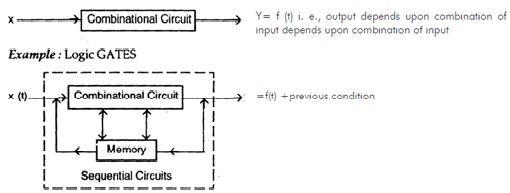EVOLUTION OF MICROPROCESSOR :
The digital circuits and systems may be broken into two part:
1) Sequential Circuit and
2) Combinational Circuits

Example: Counters, Flip-Flops Registers etc
It is the notion that the systems and digital circuits are the by product of the Boolean functions. Suppose any Boolean function is expressed as:
F ki (A,B,C,D ..........).
Where, k :- Number of Boolean Variables,
And i :- Total Boolean functions generated by these variables. For example, k = 4, then i = 24 = 0,1.......15.
So a Boolean function may be expressed as:
fki (A,B,C,D)
Where i = 0, 1.......15.
Example: Assume a function as:

Here k = 4, and i = 1;
This function may be realized in a number of ways depending upon the types of the technologies used:
(i) Discrete Element: The utilization of discrete element for realizing any function was the first technology used before the year 1960 and had to produce each Boolean variable from discrete elements to realize the overall function.
In this approach, each variable was realised independently and these are joint to get the functions. The performance of the assembled circuit depended upon the individuals how neatly he could do it apart from the complicated circuit. It required frequently much more time for assembling and every one had to assemble it independently in his own way. It created problems in automated working environment.
(ii) SSI: The innovation in the semiconductor technology forced the engineers and scientists to think several times to put them as a package either in the single IC form or in form of hybrid. In 1965, the development of Integrated circuit technology came into existence that gave the option of packing 100 transistors on the single chip. By this time the 2 technologies that names were MSI (< 100) and SSI (< 10) were used to produced and realise functions. In the SSI technology B'C, AB, CD, A'B was generated separately for realising the overall function. Hence, SSI required 5 - chips, 1 each for B'C, AB, A'B, CD and AB +B'A+A'B+CD.
(iii) MSI: In the MSI technology B'C +AB and A'B+ CD were generated separately for realising the overall function. So in the SSI technology more than 4-chips were required where in MSI technology more than 2-chips were required only for realising the same function. This technology was used between 1965 to 1970.
(vi) LSI: The continued research in semiconductor technology resulted into realisation of more functions due to high packing density. thus the LSI technology increased further and the facility of packing transistors on a single chip up to a few thousands. With this technology, all functions could be realised with only 1 chip. For large values of k, the function became more complexes and it cannot be possible to realise the all function by a single chip. The continued research in the semiconductor technology resulted in the development of the VLSI technology where in many more components could be packed on a single chip.
The continued development of IC technology resulted in realisation of more complexes functions with better reliability, compactness, low power dissipation and low cost. Figure explained different stages of integration. Chips like memory devices, counters, etc. were developed by using LSI and MSI technologies. With passageway of time, the IC technology developed at an unbelievable pace and all Boolean functions could be realized only on a single chip. The chip that capable of processing all Boolean functions was given the name of Processor. On the same line, the chip which processed the data in a controlled manner was known as the microprocessor.

There were people who said that the microprocessor was the accidental by product of the general process for 'manufacturing the high density semiconductor memories by using MOS-LSI technology. At the end of the 1960-70 decade, the need for this type of technology which placed thousands of transistors on just a single chip became compulsory. However, it was not till fully clear as to which function could use several devices effectively. Of course, Memories were one among such functions. With the development and design of such semiconductor memories, the need of a similarly difficult and efficient processor was felt which not only were able to utilize them well but could pave the way for the selling of semiconductor memories simply.